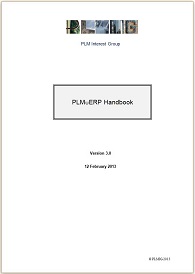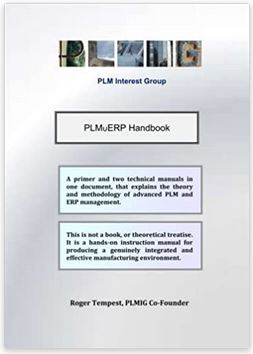|
PLM Interest Group |
|||||||||||||||||||||||||||||||||
|
|
|
|
|||||||||||||||||||||||||||||||
|
|
|
|||||||||||||||||||||||||||||||
|
|
|
|
|||||||||||||||||||||||||||||||
|
PLMuERP Handbook Background
The relationship with ERP has always been one of the most complicated areas of PLM. User companies worldwide have invested millions of dollars to make their interfaces work, but every solution is bespoke.
The problem is not that we know too little about the subject. A vast amount of experience has been gained of managing PLM and ERP within users, vendors and consultancies. The challenge is to clarify the whole picture in a Workshop environment with experienced practitioners.
It has become clear that the traditional view of PLM and ERP as "separate things that need integrating" is incorrect. In fact, PLM and ERP are different representations of the same thing. The only reason we have to spend so much effort integrating them nowadays is because they evolved separately, from the ground up. If we could start now, armed with all our knowledge and technology, we would not create PLM or ERP. We would build one single product management system for the entire enterprise, that manages the data from its first inception right through the manufacturing and build to field service and support. Instead of "PLM-ERP", this is better expressed as:- This concept of having PLM and ERP people, processes and technology working together in a harmonised way is fundamental to what we are trying to achieve. No longer are we talking about fixing a split between two computer platforms by using some kind of "interface sticking plaster". We are now working on the basis of a union between PLM and ERP in which everyone feels part of the same team, and works towards the same goals by following the same plans.
The Solution
The PLMuERP Handbook is the definitive, neutral working manual for international PLMuERP best practice. It is available in 2 formats:-
The electronic format enables easy circulation of the various documents to appropriate stakeholders and technical specialists. It also allows the material to be edited or reshaped to suit the particular needs of your project.
Whichever format is used, the Handbook is just as useful for the ERP Team as for the PLM Team. This enables the two disciplines to work seamlessly together to develop a joint, shared and agreed position on the current implementation and possible future plans. Applied Improvement
The scope, detail and accuracy of the Handbook is unmatched, and is the result of the intensive workshop and feedback process that led to its creation. For the first time, there is a clear explanation of how the optimised PLMuERP environment should be structured and managed. The Handbook explains the facts, and equips its users with the tools and techniques to achieve long-term, fully-effective enterprise product management. Even where companies are running successful PLM-ERP implementations, and are using proven integration tools, customisation is required to match the specific environment within the company, and the interfaces typically require intensive support and management. Until now, the expertise and experience of those who have run such implementations has never been formally shared. The purpose of this Handbook is to form an authoritative guide and reference manual for PLM-ERP so that the ground rules for its implementation are well understood, eliminating uncertainties and providing guidance for a straightforward implementation process. How to Obtain the Handbook
The PLMuERP Handbook, PLMuERP Primer and Data Management Manual can be purchased in electronic format as a self-contained Toolset from the Store. Alternatively they are part of the full set of PLMIG material provided as part of PLMIG Membership. The Handbook is available in paperback format directly from the Amazon PLMIG page. You can request more information via plmerp@plmig.com. © Copyright 2025 PLM Interest Group |
||||||||||||||||||||||||||||||||
| <<< Return Home | |||||||||||||||||||||||||||||||||
|
|
|
|
|||||||||||||||||||||||||||||||







